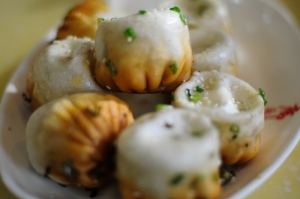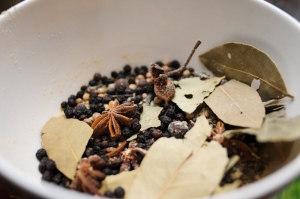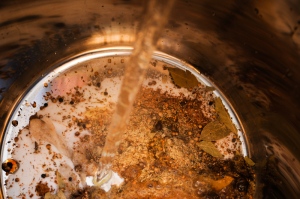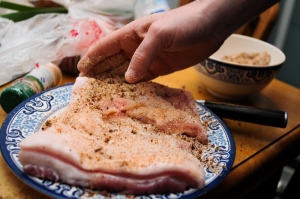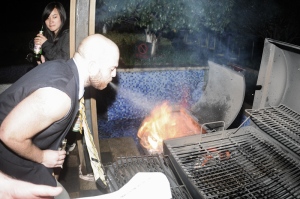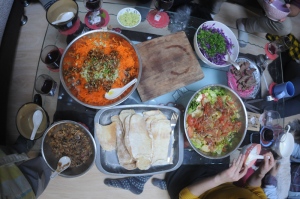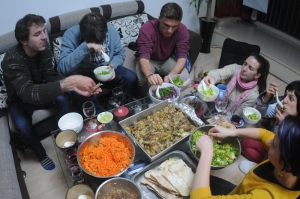Let me get this out of the way. China has an extremely rich and enduring culinary tradition. Chinese food is available in pretty much every corner of the globe, and even the cheap American knock-off version ain’t half bad. The many varieties of cuisine under the ‘Chinese food’ umbrella use pretty much every cooking method and ingredient imaginable. From lavish tables overflowing with a colorful bounty of dishes to 20 cent pork buns so good you’ll want to fly home and slap your mother, it is next to impossible to go unsatisfied. I cannot rave enough about how awesome eating in China is.
I kicked a small child in the shins after eating these soup dumplings.
That being said, there are some things which are lacking here. Namely, pastrami, the king of the deli meats.
After a trip home for the holidays and a subsequent excursion to New York City on the way back to China, I had eaten enough of the stuff to know that living without it now would be completely unacceptable. I checked everywhere, from the overpriced gourmet market to Taobao, China’s version of Amazon marketplace. Bupkis.The only solution? Stop kvetching and make it ourselves.
As a full-fledged WASPy gentile lacking any real knowledge about how pastrami was made, I needed some guidance on the matter. For that I went to my barbeque and charcuterie bible, or Torah in this case, AmazingRibs.com to an article on the subject. It is a wonderfully-written article, complete with the history of pastrami and loads of anecdotes and is worth a read even if you’re not interested in making your own pastrami.
http://amazingribs.com/recipes/beef/close_to_katzs_home_made_pastrami.html
There are about 20 or so spices involved from start to finish in the making of pastrami. After shopping online for these spices, I now have enough of them to pickle an entire herd. This time, however, we limited ourselves to about half a dozen pounds.
Pictured: 1/210th of spices I procured from the orient
To make pastrami, you first need to make corned beef. This process starts with mixing a great number of spices together with salt, sugar and water to create a brine. Beef brisket is then soaked in this brine for about a week. When that’s finished, you’ve got corned beef.
In case you were wondering, this smells like a mixture of wit, sarcasm and guilt.
We happened to be at this stage a few days before St. Patrick’s day, so we set aside a few pounds of the corned beef to make a traditional corned beef hash brunch on everyone’s favorite day of whiskey and poor decisions.
Poor decisions such as this hat.
The next step in the process is putting a dry rub on the corned beef and letting it sit for a few days, which I viewed as essentially ‘baconizing®’ the corned beef, baconizing® being both a term I just coined and something I’ve grown quite familiar with. The rub, however, is not quite as simple as the whimsically pure salt and sugar combination used for turning pork belly into bacon. Again there was another round of spices being used here, including mustard powder and paprika. I’d saved the parts of the brisket with the most speck for making the pastrami, as there are very few things in this world that make me quite as verklempt as smoked animal fat.
The next and final step in the process of making the pastrami was smoking it. I’d also gone ahead and skinned and cured some pork belly since we’d be already be smoking.
Baconized® pork belly
We timed everything so that smoking night would coincide with the night St. Patrick’s Day, because what could possibly go wrong when alcohol and fire combine?
Responsibility is the name of the game when smoking meats
We used applewood chips and charcoal to smoke the pastrami, which gave both the pastrami and the bacon a really nice flavor that made me just a little homesick, which was fine because between the whiskey and ‘taste tester’ portions we’d cut out for ourselves, I was a little sick in general, so it wasn’t that noticeable.
It’s best to let the pastrami ‘rest’ in the fridge for a few days before serving it. Traditionally, one would steam the whole piece before carving it against the grain to form tender, juicy slices. I also had some luck just slicing it up and frying it like bacon. Though several sandwiches were made for testing purposes in the meantime, the pastrami made its first major appearance at Passover, where Baranga served it alongside several extremely delicious and much healthier items.
“Don’t mind me, I’ll just sit over here in the corner.” – the pastrami
A little cliche, or perhaps ‘over-jewing’ it (thanks, B)? Maybe. But from an admittedly goyish perspective, Passover seems to be on some secular level about having a nosh with people you care about when you’re far away from home. For that, it was perfect.
L’chaim, y’all!
all photos by Baranga

